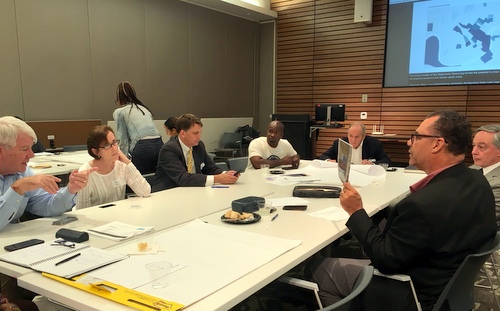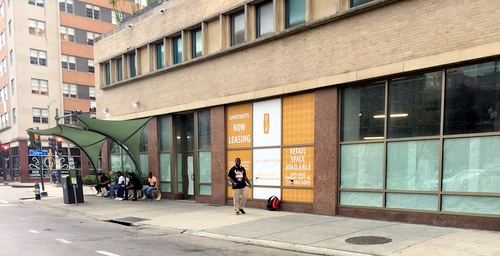
Stakeholders including GNOF’s Andy Kopplin, former Council candidate Tilman Hardy and former Councilmember Oliver Thomas discuss options for Spirit of Charity District at community meeting. (photo by Danae Columbus for UptownMessenger.com)

Danae Columbus, opinion columnist
Though there is much progressive talk in New Orleans these days about the need for economic and social equity, the viability of the redevelopment of Charity Hospital and its surrounding footprint will be decided in part by the willingness of Mayor LaToya Cantrell, the City Council and the judges of Civil District Court to relocate into the former hospital. Without their participation, the overall development – with its strong commitment to affordable housing, DBE participation, training and workforce development – would suffer from a severe funding gap. A significant public subsidy would be needed to get the project off the ground. An “active tenant” such as city government is necessary to make the project’s financial numbers work.
Officially known as the Spirit of Charity Innovation and TIF (Tax Increment Financing) District, there is currently very little non-government economic activity within the district’s footprint from which to derive tax increment financing. Current residents of the district are few but include those living in the Krauss building, portions of the former Iberville development, in senior housing on Canal Street and in the homeless encampment along Claiborne Avenue.
Under the leadership of successful shopping center/real estate developer Jimmy Maurin, LSU’s Real Estate and Facilities Foundation was tasked with selecting a developer for the Charity project. In 2017 they commissioned the Urban Land Institute (ULI) to interview dozens of stakeholders and provide recommendations which were incorporated into the request for proposals. The LSU Foundation is currently reviewing presentations from the two finalists and is scheduled to announce their selection in October.
Even though the proposals had been submitted, LSU engaged the Greater New Orleans Foundation to conduct three lively, well-attended city-wide community workshops which wrapped up this week. Recommendations from that fast-track process will be available Sept. 15, though it seems odd that the workshops didn’t take place until the end of the proposal process. One explanation is that they were held mostly to minimize future complaints from grass-roots organizers who could have said they didn’t have input into the process. Yet attendees – including preservationists, urban planners, advocates of improved mental health services, neighborhood leaders, and homeless services supporters – reveled in the opportunity to voice their opinions.
ULI recommended a series of potential residential and commercial uses including workforce (affordable) housing, a museum highlighting Charity’s history and importance to the community, retail, government, technology and or research, and education and workforce development. Market rate apartments or medical tenants focused on wellness were secondary uses. A hotel was not recommended nor was supportive housing and other services for the city’s homeless population. Whatever recommendations are adopted, the District must be safe for residents and visitors around the clock. Currently the neighborhood is dark and foreboding in the evening hours with only the wail of ambulances to break the silence.

Officials say underutilized retail space is part of the reason the Charity development district is needed. (photo by Danae Columbus for UptownMessenger.com)
In order to create tax increment financing, many believe a significant retail component is necessary including a plethora of new shopping options throughout the corridor – which stretches from Iberville to Poydras, Claiborne to Loyola. Some would be major retailers. Some could provide the kind of mom-and-pop services residents needs – a cleaners, florist, drug store, etc. This has the potential to develop into a 21st Century version of the old Canal Street and provide tax dollars that could be used to attract businesses with better-paying jobs. An emphasis on wellness is also right on point with Louisiana’s high incidence of cancer, HIV and diabetes – especially among African-Americans.
There is also no question that the 80-year-old, 1.2 million square foot Charity Hospital and its surrounding neighborhood is in desperate need of a creative revitalization utilizing “best in class development practices.” It also makes sense that the District capitalize on innovation – bio-innovation tied to the already vibrant medical corridor. Creating associated businesses, training workers for those careers, and offering housing that employees can afford is essential to ending the City’s dependence on low-paying hospitality industry jobs and moving our stagnant economy forward.
The future of the city’s homeless population also needs to be adequately addressed in a holistic – not piecemeal – fashion. Perhaps a separate inclusive footprint with appropriate housing, daytime facilities, medical, education, training and supportive services should be created along the Earhart corridor. This campus would also free up the space currently being occupied by homeless services providers in the old VA hospital.
Yet, the overall financial viability of this project as currently envisioned could be jeopardized if city government and the courts are unwilling to take that leap of faith and relocate to the new Charity. Their move would open up another significant development parcel that could be re-imagined for a sports use, creating even more jobs and economic activity.
In 1736 – just 18 years after the City of New Orleans was founded – French sailor and shipbuilder Jean Louis provided a grant to build a “charity” hospital. It became the second oldest continuously operated public hospital in the U.S. The Sisters of Charity took over the facility in the 1830’s. After providing services at five other locations, the Tulane Avenue complex was built in 1939 and operated until Hurricane Katrina.
Many New Orleanians have a personal Charity Hospital story. Throughout the decades, Charity was a place where thousands were born, treated for illnesses, worked, or even died. It’s time to write new Charity Hospital stories that speak of social and economic equity, inclusion, growth and a better future for hard-working families. The business community, city and state government, neighborhood, and grassroots stakeholders must all come together so that those stories can be written. Catch the spirit!
Danae Columbus, who has had a 30-year career in politics and public relations, offers her opinions on Thursdays. Her career includes stints at City Hall, the Dock Board and the Orleans Parish School Board and former clients such as District Attorney Leon Cannizzaro, City Council members Stacy Head and Jared Brossett, City Councilwoman-elect Helena Moreno, Foster Campbell, Lt. Gov. Jay Dardenne, former Sheriff Charles Foti and former Councilwoman Cynthia Hedge-Morrell.